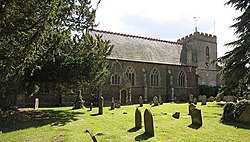Hilgay
| Hilgay | |
| Norfolk | |
|---|---|
 All Saints Church, Hilgay | |
| Location | |
| Grid reference: | TL621983 |
| Location: | 52°33’30"N, 0°23’23"E |
| Data | |
| Population: | 1,341 (2011) |
| Post town: | Downham Market |
| Postcode: | PE38 |
| Local Government | |
| Council: | King's Lynn and West Norfolk |
Hilgay is a parish in Norfolk, four miles from Downham Market.It had a population of 1,341 at the 2011 census.[1]
Other places nearby are Fordham, Ryston, Southery and Denver.
Hilgay village sits on a raised isle, some 66 ft above the surrounding fenland. Its elevation has become more pronounced as the draining of the fenland has caused the ground to shrink. It was notable in Saxon and early Norman times for the large numbers of fish and eels found there. Hilgay Old Bridge still crosses the river, but the newer A10 road bypass crosses just below it. The village stands on the river Wissey, two miles from the Ouse, three miles north-east of Hilgay fen. The parish comprises 7,860 acres of which 5,908 are in the Fens. The hall about ½ a mile from the village, belonged to the abbots of Ramsey, went at the dissolution to James Howe, belonged now to the Jones family and was rebuilt in the Tudor style in 1840."
The scholar and poet Phineas Fletcher (1580 -1650) became chaplain to Sir Henry Willoughby, who presented him in 1621 to the rectory of Hilgay, Norfolk, where he married and spent the rest of his life.
George William Manby, who lived for much of his life in Hilgay, is buried in the churchyard, and his memorial celebrates his invention of a rocket to send a line to ships in distress. Prototypes were tested from the roof of the church tower, and he was awarded £2,000 by Parliament, as use of the device had saved 230 lives by 1823.[2]
There was once a Hilgay railway station on the Fen Line.
References
Bibliography
- Andrew Hunter Blair (2006). The River Great Ouse and tributaries. Imray Laurie Norie and Wilson. ISBN 978-0-85288-943-5.
Outside links
| ("Wikimedia Commons" has material about Hilgay) |